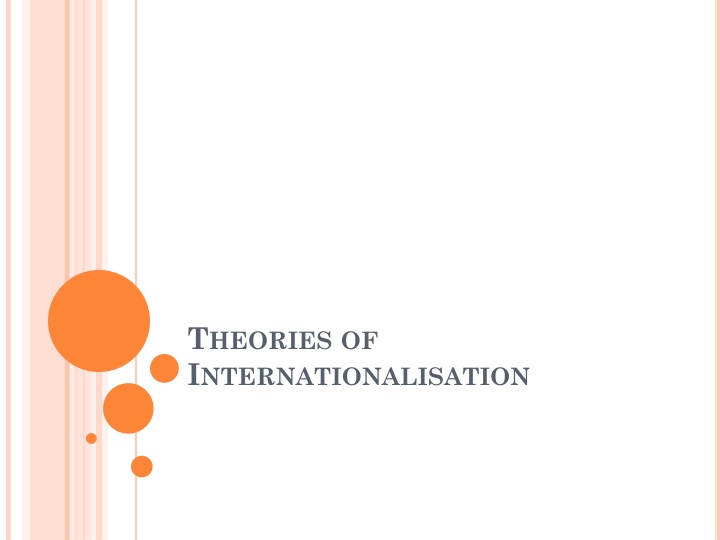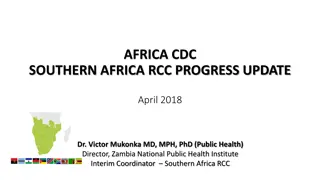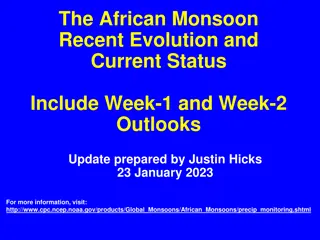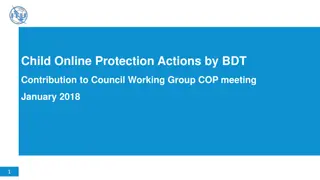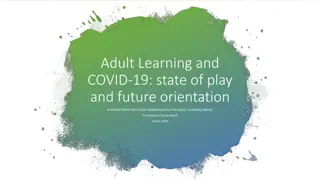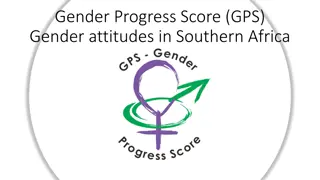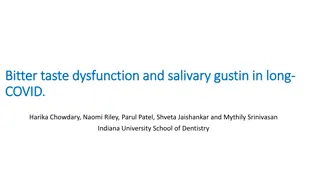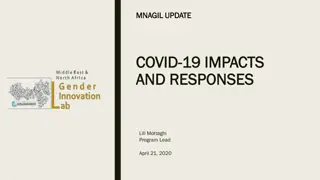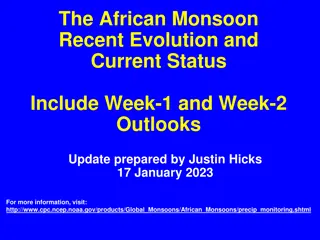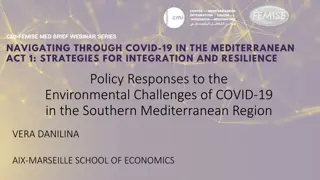COVID-19 Impacts and Responses in Southern Africa
COVID-19 has impacted Southern Africa economically and socially. The region is facing challenges in healthcare, economy, and food security. Various countries have implemented response strategies to combat the spread of the virus and mitigate its effects. The pandemic has led to economic contraction, increased debt levels, and food insecurity across the region.
Download Presentation

Please find below an Image/Link to download the presentation.
The content on the website is provided AS IS for your information and personal use only. It may not be sold, licensed, or shared on other websites without obtaining consent from the author.If you encounter any issues during the download, it is possible that the publisher has removed the file from their server.
You are allowed to download the files provided on this website for personal or commercial use, subject to the condition that they are used lawfully. All files are the property of their respective owners.
The content on the website is provided AS IS for your information and personal use only. It may not be sold, licensed, or shared on other websites without obtaining consent from the author.
E N D
Presentation Transcript
THEORIES OF INTERNATIONALISATION
THE DEGREE OF INTERNATIONALISATION OF A FIRM (Sullivan 1994) Foreign sales as a percentage of total sales Foreign Assets as a % of Total Assets Overseas Subsidiaries as a % of total subs Physical dispersion of international operations Top Managers international experience Gap Analysis (Piercy 1982) How international is it, can it be and it wants to be
HISTORICAL DEVELOPMENT OF INTERNATIONALISATION THEORIES Traditional Marketing Approach focus on firms core competencies & opportunities Life Cycle Concept International Concept (see Topic 2 & Tutorial 2) The Uppsala School Approach - sequential pattern of entry to foreign markets Internalisation/Transaction Cost Approach focus on firm based transactions via FDI rather than market-based (externalisation) - licensing 1. 2. 3. 4.
5. Dunnings Eclectic Approach ownership advantages, location advantages, internalisation advantages 6. The network approach - international org is not an isolated entity but rather should be viewed in relation to others.
THE UPPSALA INTERNATIONALISATION MODEL The Stage Model Based on Swedish study of manuf firms going international university of Uppsala model asserts that internationalisation is a slow incremental process, whereby the lack of market knowledge and uncertainty is reduced in an experiential learning process resulting in a gradual increase of activity in terms of foreign sales and foreign direct investment
Manufacturers began in nearby markets & gradually moved further away The process of Internationalisation was started with exports
Johanson and Weidershein-Paul (1975) Stage 1: No regular export activity (sporadic export) Stage 2: Export via independent reps (export modes) Stages 3: Establishment of a foreign sales subsidiary Stage 4: Foreign production/manufacturing units
Increasing Commitment: The amount of resources committed Degree of commitment finding an alternative use for the resources Internationalisation requires: Market knowledge through experience General knowledge of operations
A direct relationship exists between market knowledge the more market knowledge, more likely to invest in resources, more likely to commit
CRITICAL VIEWS OF THE UPPSALA MODEL Too deterministic & linear Does not take into account interdependencies Not valid for service industry Firms today leapfrog stages entering distant/psychic distant markets earlier due to the homogeneousation of markets (which reduces psychic distance) internationalisation is faster
Leapfrog sequential approach and go straight for FDI due to experience gained in other markets Is it relevant in highly International & Global firms and industries? Knowledge is more abundant today so the slow incremental experiential collection of knowledge is no longer required Number of people experience in foreign business has increased
assumption that lack of market knowledge and uncertainty in the decision process is always present, except when market conditions are stable and homogenous and/or when the firm has considerable experience from markets with similar conditions (Johanson andVahlne, 1977, 1990).
Most critics still support the model and no replacement (as of yet) will suffice although the born globals may change this
THE TRANSACTION COST ANALYSIS (TCA) MODEL suggests firms choose the least-cost international location for each activity they perform and grow by internationalizing markets, bringing interdependent activities under common ownership and control up to the point where the benefits of further internationalization are outweighed by the costs. Based on an internal hierarchical system to control
Transaction costs fail when markets fail to operate under requirements of perfect competition ( friction free ) Cost of operating in such markets is 0 So there is no need to impose restrictions of free market exchange but there is always friction which causes transaction costs
Transaction Cost = ex ante costs costs) + ex post costs (Monitoring & enforcement costs) (search & contracting =
Friction based on opportunistic nature - self interest objectives Misleading, disguising, distortion, and confusion
Ex ante costs: Search costs cost of gathering information to evaluate potential intermediaries. For distant markets can be very high if mkt info is lacking Contracting Costs costs associated with negotiations Ex post costs: Monitoring costs costs associated with monitoring agreements etc Enforcement costs; costs associated with sanctioning
If the TCs through externalisation (e.g. Through an importer or agent) are higher than the control costs through an internal hierarchical system, then the firm should seek international activities, i.e. Implementing teh global marketing strategy in wholly-owned subsidiaries. Or if the friction between buyer and seller is too high then the firm should internalise in the form of its own subsidiaries.
LIMITSOFTHE TCA MODEL Narrow assumptions of human nature opportunism & economic self interest Calculative Commitment & Trust Counter with RM and Affective Commitment & trust Excludes internal TC s i.e. friction between Head office and subsidiaries Relevance for SME s often have to externalise Importance of production costs is understated over estimation of transaction costs
THE NETWORK MODEL Based on the Uppsala model (Johanson & Vahlne 1990) - process of internationalisation through a network perspective. developing networks of business relationships in other countries through extension, penetration, and integration (c.f. Johanson & Mattsson 1988). Extension = investments in networks that are new to the firm Penetration = developing positions and increasing resource commitments in networks in which the firm already has positions. Integration = co-ordination of different national networks.
If the relationships between the firms are seen as a network this implies that companies internationalise because other firms in their (inter)national network are doing so. Because in industrial/ B2B marketing firms engaged in the production, distribution, and use of goods and services depend (specialisation) Other industries will internationalise because of the world economy
internationalisation = cumulative process whereby relationships are continually established, developed, maintained, and dissolved gradual learning and development of market knowledge through interaction within networks. Position in the network: micro (firm-to-firm) or a macro (firm-to-network)
Network perspective - internationalisation strategy of a firm can be characterised by the need to 1) minimise the need for knowledge development 2) minimise the need for adjustment 3) exploit established network positions (Johanson & Mattsson 1988), (agents or consultants).
FOUR CASESOF INTERNATIONALISATION Degree of internationalisation of the network: Low High The early starter The late starter Low Degree of internationalisation of the firm The lonely international The international among others High (Johanson & Mattsson 1988).
The early Starter: competitors, customers, suppliers and other firms in the market don t have important international relationships The Lonely International: firm has experience of relationships with others in foreign markets The late starter: the les internationalised firm can be pulled out of the domestic market by its customers & suppliers The International Among Others: in the network - can link over to other networks
BORN GLOBALS Australian study by McKinsey Firm typically starts to export less than two years after the foundation of the firm. Young firms. these firms view the world as their marketplace from the outset and see the domestic market as a support for their international business. (McKinsey & Co., 1993, p.9)
high-tech firms, higher growth rates than other industries a large growth in their export compared to their home-market sales. A major factor in the explanation of the phenomenon Born Global in (McKinsey & Co., 1993) is the management s commitment to internationalization Major factor is firm s ability to standardize production, marketing, etc. globally instead of developing customized products.
Defn: Firm that from its inception derives competitive advantage from the use of resources and the sale of outputs in multiple countries (Oviatt & McDoughall 1994)
Characterised by: SME s with less than 500 employees Annual sales $100m Reliance of cutting edge technology Unique product & process innovations Management visionary Knowledge based Management Operate in specialised networked with partners Narrowly defined customer groups high customer orientation High Flexibility Operate in the borderless marketplace Born Again Global Firms
Differences Between Traditional Firms And Born Global (Bell & McNaughton 2000) Motivation to internationalise reactive International increase sales Objectives survival International incremental Expansion domestic first Pattern less sophisticated Markets Limited networks Pace gradual Slow internat Single mkt @ a time many markets at a time Method of Distribution Conventional Use of Agents & Distributors International Strategies Ad hoc & Opportunistic Reactive behaviour To export Proactive active search competitor advantage first mover advantage concurrent simultaneous lead markets strong networks rapid speedy internationalization Flexible client integration licensing and joint ventures Structured Planned approach
